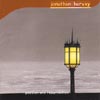Harvey Passion and Resurrection
Dynamic performance of a score poised between the hieratic and the dramatic
View record and artist detailsRecord and Artist Details
Composer or Director: Jonathan Dean Harvey
Genre:
Vocal
Label: Sargasso
Magazine Review Date: 11/2004
Media Format: CD or Download
Media Runtime: 85
Mastering:
Stereo
Catalogue Number: SCD28052

Tracks:
| Composition | Artist Credit |
|---|---|
| Passion and Resurrection |
Jonathan Dean Harvey, Composer
Alison Smart, Soprano Andrew Mackenzie-Wicks, Tenor BBC Singers Carolyn Foulkes, Soprano Jonathan Dean Harvey, Composer Kim Porter, Contralto (Female alto) Martin Neary, Conductor Sinfonia 21 Stuart Macintyre, Baritone |
Author: Fabrice Fitch
I wonder whether the audience were warned that they’d be called on to lend their voices to this performance, recorded by the BBC in 1999; this score is as much a ‘liturgical action’ as an oratorio (or ‘church opera’, as it is described in the booklet). It was written for a community celebration at Winchester Cathedral, and most of the text is a translation of extant Passion Plays.
Jonathan Harvey’s ability to combine chant-like idioms (and actual plainchant hymnody) within a predominantly atonal context is quite uncanny. The work opens with a familiar passage from the Book of Common Prayer which gradually morphs into more angular cadences, but there is nothing wilful in the transformation.
The libretto faithfully follows Christ’s Passion and Resurrection. In the Passion, men’s voices and low brass predominate, and the writing is harsher, more angular, the treatment of pacing more earth-bound; the Resurrection sequence points out the greater involvement of women (through their voices), and the register is consistently higher, the sense of time more suspended. There is little abstraction in the score – in fact, Harvey allows himself a degree of literal-mindedness that may surprise many; you can even hear the nails being driven in at the Crucifixion.
The action is set in a most direct way, yet never ‘talks down’ to the congregation or the listener, and the performance is dramatic and well shaped. No one performer stands out, though I wasn’t overly taken with Stuart Macintyre’s rather ‘shouty’ delivery as Christ, and the women fare rather better than the men. The BBC Singers and Sinfonia 21 have plenty of body, the strings have much to do, and the brass interventions are most striking (the postlude is quite literally ‘recessional’, as very low instruments gradually disperse throughout the church of St John’s, Smith Square). This spatial element stands in for many of Harvey’s preoccupations, and the effect is nicely rendered by the engineers.Fabrice
Jonathan Harvey’s ability to combine chant-like idioms (and actual plainchant hymnody) within a predominantly atonal context is quite uncanny. The work opens with a familiar passage from the Book of Common Prayer which gradually morphs into more angular cadences, but there is nothing wilful in the transformation.
The libretto faithfully follows Christ’s Passion and Resurrection. In the Passion, men’s voices and low brass predominate, and the writing is harsher, more angular, the treatment of pacing more earth-bound; the Resurrection sequence points out the greater involvement of women (through their voices), and the register is consistently higher, the sense of time more suspended. There is little abstraction in the score – in fact, Harvey allows himself a degree of literal-mindedness that may surprise many; you can even hear the nails being driven in at the Crucifixion.
The action is set in a most direct way, yet never ‘talks down’ to the congregation or the listener, and the performance is dramatic and well shaped. No one performer stands out, though I wasn’t overly taken with Stuart Macintyre’s rather ‘shouty’ delivery as Christ, and the women fare rather better than the men. The BBC Singers and Sinfonia 21 have plenty of body, the strings have much to do, and the brass interventions are most striking (the postlude is quite literally ‘recessional’, as very low instruments gradually disperse throughout the church of St John’s, Smith Square). This spatial element stands in for many of Harvey’s preoccupations, and the effect is nicely rendered by the engineers.Fabrice
Discover the world's largest classical music catalogue with Presto Music.

Gramophone Digital Club
- Digital Edition
- Digital Archive
- Reviews Database
- Full website access
From £8.75 / month
Subscribe
Gramophone Full Club
- Print Edition
- Digital Edition
- Digital Archive
- Reviews Database
- Full website access
From £11.00 / month
Subscribe
If you are a library, university or other organisation that would be interested in an institutional subscription to Gramophone please click here for further information.




